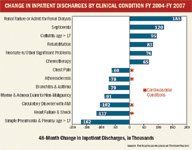Inpatient trends 2004-2007
Drill into your own data to see whether and to what degree these national inpatient trends are occuring in your own area.
HEALTH PLANS that are hoping to reduce inpatient volumes would be best served by reviewing their reimbursement and provider incentives for preventive care, say experts.

Obviously, a hospital inpatient admission typically represents the most expensive form of service or treatment, says Marc Mertz, senior manager with The Camden Group, national healthcare advisory firm based in Los Angeles.
RENAL FAILURE GROWS
According to Thomson Reuters, the fastest-growing clinical condition is renal failure, specifically acute renal failure. The reasons for this growth are not fully known, but may be due to the increased rate of diabetes and hypertension, expanded criteria for diagnosing renal failure, and coding changes.
Increasing reimbursement rates for relatively low-cost services such as preventive exams and screenings can reduce admission rates, Mertz says.
"For example, renal failure discharges, which according to [Thomson Reuters] had the highest growth rate, can be reduced by encouraging patients to have annual exams and blood work," he says. "One of the best ways to accomplish this is to provide quality incentives to primary care physicians. The alignment of patient, provider, and payer incentives can, in this case, result in higher quality care and less expense to the healthcare industry."
Another finding from Thomson Reuters shows the demand for major cardiovascular care continues to decline.
"Our prior research has shown that the prevalence of heart disease in hospital patients has increased-as expected-with the aging population," says Dr. Schutt. "However, heart disease is increasingly less likely to be the primary reason for hospitalization, most likely due to long-term population treatment for risk factors such as elevated cholesterol and high blood pressure."
Executives should drill into their own data to see whether, and to what degree, these national trends are occurring in their service areas.
"There is great variation around these types of indicators, and the national average may not reflect what is happening in any given locality," Dr. Schutt says. "Managed care executives should make decisions based on a sound understanding of the local picture."
Mertz agrees that healthcare trends and utilization rates can be highly localized depending on variations in patient populations, physicians, and the availability of services and facilities.
"It is imperative that plans understand what their service area data indicates rather than what national trends suggest," he says. "The accessibility of pertinent and accurate data will continue to be key to organizations' success."
-Tracey WalkerCommentary is independent of source data
Conversations With Perry and Friends
April 14th 2025Perry Cohen, Pharm.D., a longtime member of the Managed Healthcare Executive editorial advisory board, is host of the Conversations with Perry and Friends podcast. His guest this episode is John Baackes, the former CEO of L.A. Care Health Plan.
Listen
Ohio’s Medicaid Work Requirement Efforts Aim to Boost Engagement, Avoid Coverage Loss
April 18th 2025Maureen Corcoran, director of the Ohio Department of Medicaid, believes the work requirement policy can be both a financial and moral effort to improve the lives of Medicaid consumers.
Read More
Breaking Down Health Plans, HSAs, AI With Paul Fronstin of EBRI
November 19th 2024Featured in this latest episode of Tuning In to the C-Suite podcast is Paul Fronstin, director of health benefits research at EBRI, who shed light on the evolving landscape of health benefits with editors of Managed Healthcare Executive.
Listen
Why Better Data and Awareness Matters for Medicaid Work Requirements
April 17th 2025With policymakers considering work requirements for Medicaid eligibility, Jennifer Haley, principal research associate in the Health Policy Division at the Urban Institute, said it’s more important than ever to understand how those changes could unintentionally cause harm, particularly when data systems fall short and public awareness is limited.
Read More